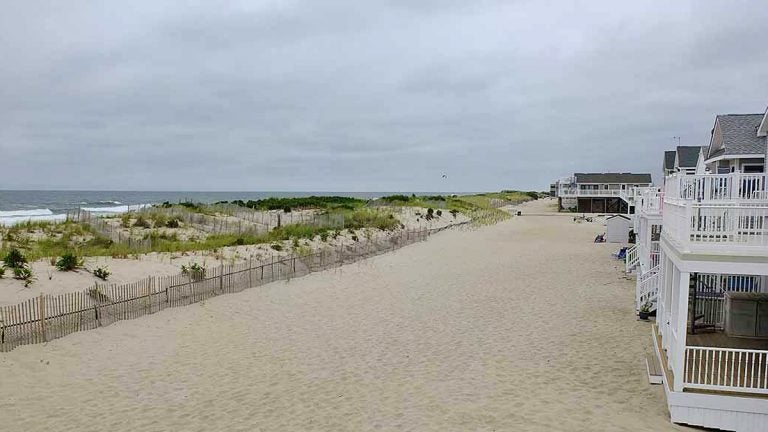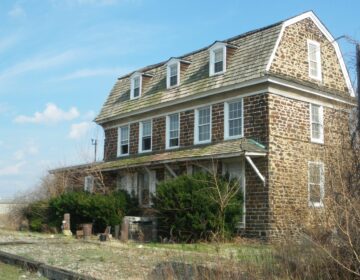Explainer: The rules that guide coastal development in New Jersey

Ocean front homes in South Seaside Park, NJ. (Alan Tu/WHYY)
Over the past half century, the population of the Jersey Shore has more than tripled, while Ocean County — the state’s fastest-growing — saw its population increase tenfold. Amid the growing desire to live, work, and vacation near the water’s edge, state and federal authorities have created a multitude of regulations to ensure that unfettered development doesn’t totally wreck the environment and put coastal residents in harm’s way during major storms.
Political leaders say they’ve sought to balance these concerns with the realization that New Jersey’s coast — and the tourism dollars it generates — is a huge driver of the state’s economy.
Still, environmental and planning advocates say the estimated $37 billion in losses and 365,000 homes severely damaged or destroyed during Sandy indicate that the rules haven’t been strict enough. If the state is to be less vulnerable to future storms, they argue we need to do much more.
What state regulations currently exist? Coastal development in New Jersey operates under a complicated patchwork of environmental, architectural, and floodplain-management rules enacted and enforced at the local, state, and federal levels.
Historically, the most significant state regulations governing coastal construction were the Department of Environmental Protection’s Flood Hazard Area Control Actand the Coastal Area Facility Review Act (commonly known as CAFRA), which put in place a set of basic rules aimed at protecting the ecology of the shore. In order to minimize damage to life and property as well as preserve water quality and the environment, these acts governed how and whether people could build in areas prone to tides and flooding. Adopted in 1973 before the coastline was totally developed, CAFRA played an important role in dictating the types of permitted construction in the decades that followed, leading to the look and feel of the Jersey Shore that we’re familiar with today. Earlier this summer, the D.E.P. consolidated CAFRA and a number of other land use regulations into a single chapter of Coastal Zone Management Rules.
Among the panoply of other regulations builders have to comply with are the Waterfront Development Act, Freshwater and Tidal Wetlands Acts, Water Quality and Supply Management Acts, Clean Water Act, and the State Plan.
Other oversight: On the federal level, the U.S. Army Corps of Engineers, National Marine Fisheries Service (under NOAA), and U.S. Fish and Wildlife may all have a say in the building-permitting process, since developers are required to notify them when they apply for state construction permits. The Coast Guard also gets involved if navigability is an issue, such as with bridges.
Though it has limited applicability in the state (due to the fact that so much of the coast is built up), the federal Coastal Barrier Resources Act comes into play in Sandy Hook, Island Beach State Park, and the Forsythe National Wildlife Refuge by making any construction in those areas ineligible for federal flood insurance, thus discouraging risky development and encouraging land preservation.
Residents also have to adhere to any applicable zoning requirements or building elevation restrictions on the local level. For example, federal rules dictate that new construction or rebuilding of substantially damaged homes (those damaged more than 50 percent) in coastal areas must now be elevated at least two feet above the hundred-year floodplain (the height of a flood that has a 1 percent chance of occurring annually), but some municipalities like Tuckerton and Monmouth Beach are even more restrictive, requiring an additional foot of elevation to keep homeowners out of harm’s way.
Christie Administration’s Stance in the Aftermath of Sandy: In a recent press release, the governor’s office said it’s committed to a long-term recovery strategy of “rebuilding stronger and smarter, and ensuring New Jersey’s communities and infrastructure are more prepared to withstand future storms.” Among the elements of that strategy are working with the Army Corps on a variety of beach restoration and dune projects (and filing eminent domain proceedings where necessary toacquire easements from the remaining holdouts), constructing additional stormwater management infrastructure, wetlands restoration, and building sea walls and other flood control projects. But aside from about 700 voluntary buyout offers the state has extended thus far, there’s been fairly little discussion of moving people out of flood-prone areas, preventing them from rebuilding in vulnerable areas, or placing stricter limits on future coastal construction.
What Critics Say About Coastal Development in NJ: Regulations like CAFRA did have their intended effect of preventing the construction of large-scale, waterfront developments like industrial facilities and apartment buildings. That’s why most of the Jersey Shore isn’t built up with rows of high rises like Miami Beach. But many experts, environmentalists, and planning advocates say in retrospect that the rules didn’t go far enough.
“There was a reasonable belief among many lawmakers at the time that if you controlled the large developments, you could control the overall development patterns of the shore,” said John Weingart, who worked on coastal issues at the DEP. for close to two decades. History has proven that assumption wrong, he explained. While preventing apartment buildings, CAFRA placed few restrictions on developments of less than 25 units — including single-family homes – allowing them to be built without applying for DEP permits, as long as they were in compliance with local zoning codes.
As a result, almost half of the development along the Jersey Shore over the past few decades has involved projects with fewer than 25 units, leading Weingart and his colleagues to joke that one day, archeologists will dig up the Jersey Shore and think the number “24” had religious implications.
The numerous local, state, and federal construction regulations have probably translated to more paperwork, time, and professional resources that give developers a headache, said John Miller from the New Jersey Association for Floodplain Management.
“I would imagine it significantly bumps up the immediate costs to owners and developers, and long-term costs in that what’s proposed does get built and then the costs are shared by the owner, insurer, and taxpayer,” after a home is destroyed in an event like Sandy, he explained. “But in the end, the regulations don’t garner a ‘no,’ as evidenced at the Jersey Shore, packed with development density.” People may see all of these regulations and think, “wow, that’s a lot of hoops to pass through,” he added, but “lots of regulations and applications do not necessarily equate to less risky development.”
Changes underway:In the coming months, it appears that further changes are on the horizon for New Jersey’s Flood Hazard Area Control Act, Coastal Zone Management rules, and Stormwater Management rules.
State officials are heralding the proposed modifications as “part of the Christie administration’s ongoing effort to add commonsense and predictability to overly burdensome state rules and regulations.”
Environmentalists led by the New Jersey Sierra Club as well as the federal Environmental Protection Agency have expressed concerns that the new regulations could weaken water and habitat protection standards and place more people and property in harm’s way during future storms.
Meanwhile, John Miller’s group — along with the New Jersey League of Municipalities — worry that the rule changes as currently written still fail to address contradictions between state and federal construction standards that could lead some Sandy victims to unknowingly follow state instead of federal regulations and make potentially costly and dangerous mistakes during the rebuilding process. The floodplain managers are also calling on the state to enforce even higher elevation requirements for buildings and critical facilities in flood-prone areas.
In the wake of several public hearings on its proposed rulemaking and a 60-day comment period that concluded at the end of July, the Department of Environmental Protection has pledged to review all of the feedback it received and address some of these concerns before issuing its final regulations by the end of the year.
______________________________________________________________
NJ Spotlight, an independent online news service on issues critical to New Jersey, makes its in-depth reporting available to NewsWorks.
WHYY is your source for fact-based, in-depth journalism and information. As a nonprofit organization, we rely on financial support from readers like you. Please give today.




